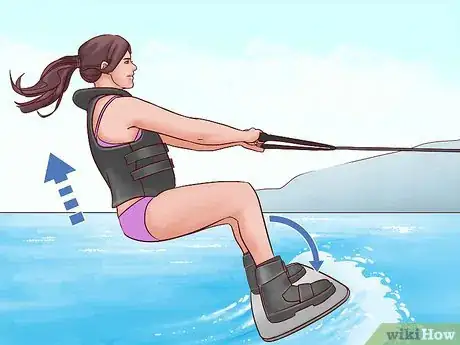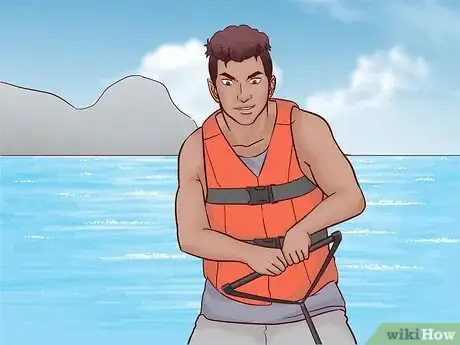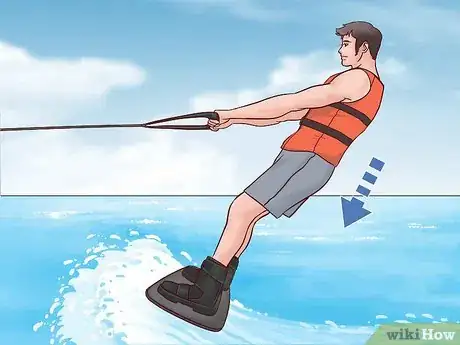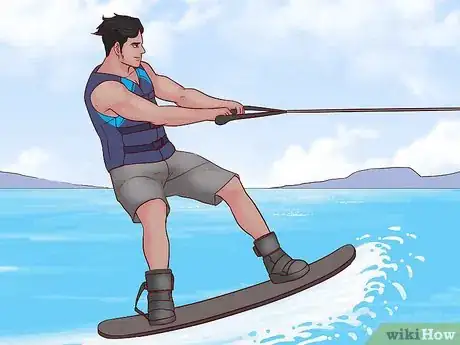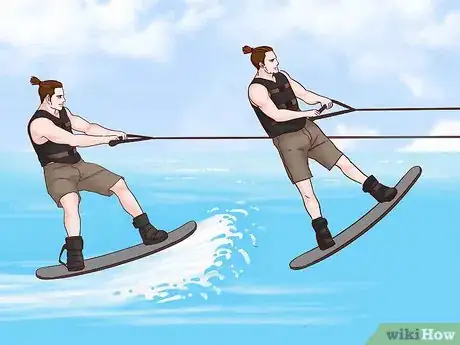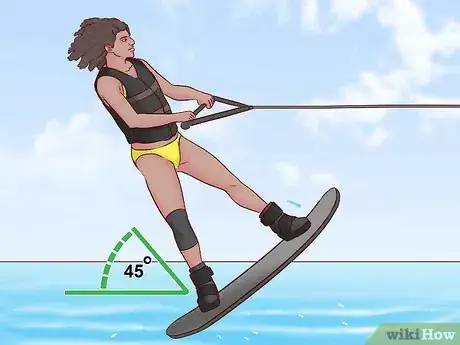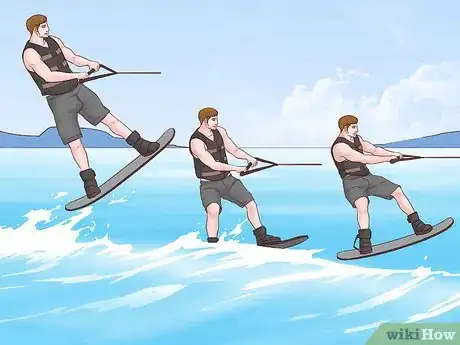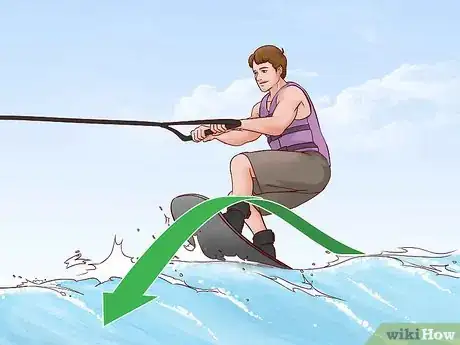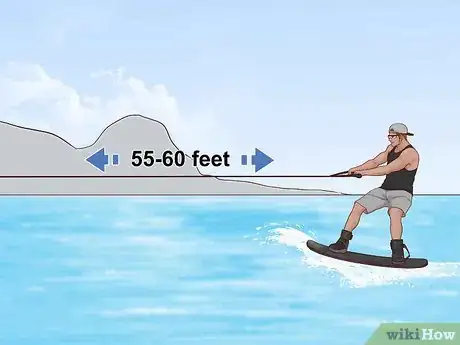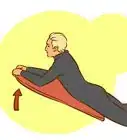This article was co-authored by wikiHow Staff. Our trained team of editors and researchers validate articles for accuracy and comprehensiveness. wikiHow's Content Management Team carefully monitors the work from our editorial staff to ensure that each article is backed by trusted research and meets our high quality standards.
There are 11 references cited in this article, which can be found at the bottom of the page.
This article has been viewed 11,735 times.
Learn more...
Learning how to jump a wake on a wakeboard is an exciting process. It can also be frustrating. While jumping a wake isn’t quite as easy as the professionals make it look, you can learn how to do it by following a few simple tips. If you keep practicing, you’ll be able to jump a wake before you know it.
Steps
Approaching the Wake
-
1Cut away from the wake by shifting your weight to your outside leg. Get as far away from the wake as you can. Continue to cut to the outside until you feel the boat begin to pull you back toward the center.[1]
- Aim to jump over just 1 wake when first learning how to jump a wake.
-
2Keep the rope pulled in near your front hip. Pull in the rope so that it is just 1–2 inches (2.5–5.1 cm) in front of your hip. This will keep the rope line taut, and put your arms in the optimal position for landing the jump.[2]
- Keeping the rope line tight throughout your approach and jump will give you a longer hang time and a softer landing.
- Maintaining a tight line while jumping is known as “loading the line.”
- Keep hold of the line with both hands during your approach and jump.
Advertisement -
3Lean back on the heel edge of your wakeboard. Once you’ve cut as far away from the wake as you can, gradually cut back towards the wake. As you’re approaching the wake, lean farther and farther back on your wakeboard’s heel edge. In other words, start by keeping the board almost flat on the water with your weight shifted slightly to your heels, then gradually lean back and shift more and more of your weight to the heel edge.[3]
- This step will allow you to maintain constant acceleration during your approach, which will help increase the height of your jump.
- This process is commonly known as “the progressive edge.”
-
4Approach the wake with your knees bent slightly. Keeping your knees bent as you approach the wake will allow you to maintain your balance as you lean farther and farther back on the heel edge of the wakeboard. Staying in this position will also help you spring up when you reach the top of the wake.
- Bend your knees just enough so that they’re not straight.
Jumping and Landing
-
1Straighten your legs as you leave the top of the wake. Push down with your bent legs as if you were jumping. Time your jump so that your legs straighten right as you reach the top of the wake.
- If you don’t straighten your legs quickly enough, your knees may absorb the wake’s impact, denying you the height you want.
- It will probably take a while before you get the timing of this step just right, but don’t give up!
-
2Continue to lean back while you’re in the air to maintain your balance. When you jump into the air, keep your body at the same angle as when you approached the wake. Make sure to maintain tension on the line.[4]
- If you don’t lean back while you’re in the air, the boat will pull you forward and cause you to crash face first into the water when you land.
- Lean back at around a 45-degree angle.
-
3Bend your knees to land on the other side of the wake. Bending your knees will help you absorb the impact of landing back on the water. As you bend your knees to get ready to land, make sure you continue to lean back at an angle so that the forward pull of the boat doesn’t cause you to fall forward.[5]
- You’ll want to bend your knees so that you are almost in a sitting position.
- After landing, cut to the outside of the wake to help yourself regain control of the wakeboard’s movement.
- You can cut to the outside by keeping your board pointed toward the outside and shifting your weight slightly to your outside leg.
Improving Your Jumps
-
1Try jumping small wakes when first starting out. While you’ll get more air when jumping large wakes, you may have trouble keeping your balance and timing your jumps well. Starting with small wakes will help you master the basics.[6]
- The slower a boat’s speed, the smaller its wake will be.
- Keep the speed of the boat at around 16–18 miles per hour (26–29 km/h) for beginner and intermediate jumpers.[7]
- As you become more comfortable with jumping small wakes, try jumping wakes that are progressively larger.
-
2Use a longer rope length when first learning how to jump a wake. Start with a rope length of between 55–60 feet (17–18 m). Using a longer rope will give you more time to approach the wake and to land your jumps. The downside of using a longer rope, however, is that it will reduce the height and distance of your jumps.[8]
- Once you’ve mastered the basics of the jump, try shortening the length of the rope. This will allow you to get more air and distance with your jumps.
- Try a rope length of between 40–55 feet (12–17 m) when you’re ready to start jumping both wakes.[9]
- Advanced wakeboarders typically ride with a rope length of between 60–75 feet (18–23 m) and a tow speed of between 21–24 miles per hour (34–39 km/h).[10]
-
3Add a tail grab to your jump after you’ve mastered landing. When you’re in the air, bend your knees and raise them up to your chest. Bring the board up to where you can reach down and grab its tail end.[11]
- Don’t start reaching for the board until you’re airborne, or you’ll alter the position of your body, which may cause you to crash.
- Try not to bend your waist when reaching down for the board.
- When it’s time to land, release the board and make sure you’re leaning back so that you’ll stay upright when the board hits the water.
References
- ↑ https://youtu.be/Uuxu3A_LrpE?t=91
- ↑ https://youtu.be/Uuxu3A_LrpE?t=51
- ↑ https://youtu.be/Cg-Z_rZdfWE?t=70
- ↑ https://youtu.be/Ckkf840HZE4?t=34
- ↑ https://youtu.be/Uuxu3A_LrpE?t=73
- ↑ https://youtu.be/FDi6N8F4yQA?t=40
- ↑ https://youtu.be/1FaQPD3F98Q?t=52
- ↑ https://youtu.be/1FaQPD3F98Q?t=42
- ↑ https://youtu.be/1FaQPD3F98Q?t=77
